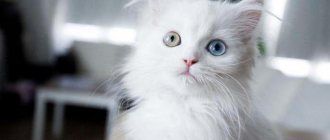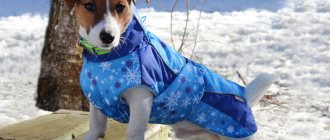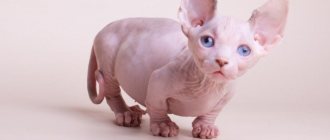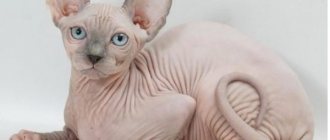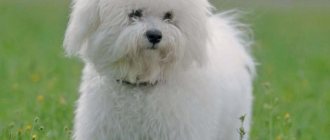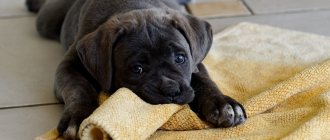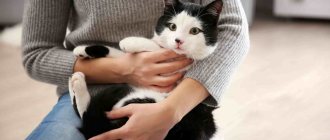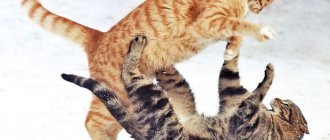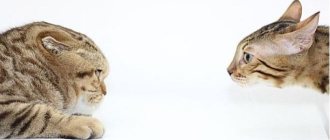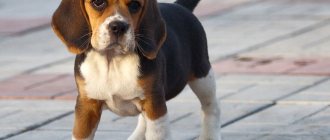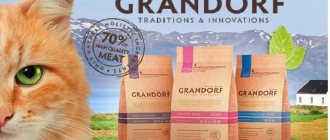The Singapura cat is one of the smallest breeds and is known for its large eyes and ears, brown ticking coat and blunt-tipped tail.
According to the research of American scientists, three animals were brought from Singapore in the 1970s and became the founders of the breed in the United States. As it later turned out, they were originally sent to this country from America. However, investigations by the Cat Fanciers' Association (CFA) found no wrongdoing and the Singapura retained its status as a natural breed, although it is a very complicated story.
History of the breed
The Singapura breed was brought to the United States in the early 1970s by Hal and Tommy Meadow, expatriates who were moving home.
Early Singaporean breeders quickly set to work to establish purebred qualities such as proper breeding, uniformity of appearance, and most importantly, health and disposition.
Today the breed is internationally recognized by most registered associations. Singaporeans were admitted to the CFA in 1982, and to participate in the championships in 1988.
In 1975, after working in Singapore, Tommy and Hal Meadow returned to the United States with three local brown cats. These three cats, a pair of male and one female kittens from the same litter, and the other a young female, were the basis used to create the Singapura breed.
In 1981, another well-known breeder visited Singapore and chanced upon a cat that matched the breed description (except for the tail) at the local Society for the Prevention of Cruelty to Animals. She was brought to the United States and included in the breeding program.
The Singapore variety was accepted for TICA registration in 1979. During this period, breeders discovered that a random litter had produced a solid-colored kitten, which was caused by a recessive gene responsible for solid color. Many of them then decided to carry out test matings in order to accurately identify and eliminate individuals with the recessive gene from their breeding programs. Two out of three breeding cats have been found to carry this gene.
In 1987, while on a cat hunting trip in Singapore, American breeder Jerry Mays discovered cargo documents indicating that three breeding cats had actually been imported into Singapore from the United States in 1974. Lucy Koh, Mace's friend, made an attempt to correct the Singapura history previously presented to the world, but it went largely unnoticed until 1990, when the Singapore Tourism and Promotions Board (now Singapore Tourism Board) began a campaign to use the breed's name as a national mascot. Reporter Sandra Davy was informed of the discrepancy and published an article about it in the national newspaper The Straits Times.
Since the cats were registered on import certificates as Abyssinians and their owners were breeders of Abyssinians, Burmese and Siamese, some felinologists have suggested that the Singapura is a cross between these three breeds, and they have even been described as such by CFA judges.
The similarity of the Burmese-Abyssinian hybrid to the Singapore cat, as well as the latter's small litter size, which is not found in natural breeds, added more doubt to the history of the species.
The CFA investigated the incident at the request of the Singapore Breed Club. During the investigation, Hal Meadow reported to the investigative committee that the three cats were the grandchildren of four local animals that he had sent back to the United States during a previous business trip to Singapore in 1971, contradicting his earlier statement about the cats being the founders of the breed.
Obviously, Tommy Meadow initially withheld this information in order to not publicize his illegal trip to Singapore.
As a result, the CFA found no violations and maintained the Singapore breed's status as a natural variety.
Joan Miller of the CFA said that "whether they mate on the streets of Singapore or in Michigan, it doesn't matter." Referring to an animal taken from the country in 1981, she said that "In addition, there is at least one documented cat that is behind many Singapura pedigrees and was picked up in that country. Even with any specimens introduced by American breeders, we still have a legitimate cat from Singapore.”
However, recent research conducted in 2007 using cat DNA showed that there are very few genetic differences between the Singapura and the Burmese, adding support to the claim that the Singapura cat is not a natural breed.
The Singapore Tourism and Promotions Board (STPB) eventually decided to use the breed (advertised as Kucinta) as a tourism mascot after the CFA completed its investigation.
The name Kucinta is a portmanteau of the Malay words kucing (cat) and cinta (love), taken from the winning entry in the naming competition. By the way, Kuchinta also means "the one I love" in Malay. The animal sculptures are located by the Singapore River.
Brown cats with colorful coats are occasionally seen here, only a few resembling the true Singapura, with most being tabby, tortoiseshell or bi-colored, and locals believe that the STPB nomination is a publicity stunt based on the breed's popularity among tourists at the time.
In 2004, Singapore Zoo hosted a temporary exhibition of Singapore's cats as part of the country's 39th National Day celebrations. Their owners lent four breeding animals for this event.
Story
The ancestors of Singapura cats are street animals that lived in Southeast Asia.
Only in the second half of the 20th century. American tourists brought cats of this breed from Singapore to their homeland. Just a year later, Singapore was presented at the exhibition. Despite the fact that Singapore cats appeared in Europe in 1987, this breed is extremely rare in European countries. In Russia there are also practically no nurseries where Singapore cats are bred.
According to statistics, cats of this breed are the smallest of the domesticated ones: the average weight of an adult is only 2-3 kg.
Breed standards vary from country to country. For example, in Singapore itself, a variety of cat colors are recognized, but in the United States, the Singapura can only come in two colors: sable-brown or ivory.
Mr. Cat recommends: description
The Singapura is a moderately stocky and muscular cat, one of the smallest in the world, with very short and fine hair.
An adult female usually weighs 1.8 kg, while the male reaches 2.7 kg.
Large, slightly pointed and deeply cupped ears along with huge almond-shaped eyes are the main distinguishing features of the breed. The tail is thin, slightly shorter than the body length and has a blunt tip.
The breed's coat pattern is tipping type or agouti. That is, individual strands of hair have alternating areas of dark and light colors, usually two shaded stripes separated by two off-white stripes, with a dark color at the tip.
The underside of the body, including the chest, muzzle and chin, takes on the color of light stripes. The Singapura is recognized in cat registries in only one color, sepia agouti, which is described as "dark brown ticking on a warm old ivory background."
The Singapura is described by the CFA as an active, curious and playful animal. Cats are affectionate and never refuse human communication. They tend to climb to high places, which allows them to see their surroundings better.
Characteristics and breed standard
The Singapura is a smaller-than-average shorthaired cat with noticeably large eyes and ears. At first glance, she resembles an Abyssinian of unusual color. The breed standard is almost the same, but upon closer inspection it is noted that the only similarity is their large ears, everything else is different.
The light beige color is unique and, according to some felinologists, resembles the coloring of a puma.
The tail is of normal or slightly shorter length, the legs are very small, the body is smaller, of medium length and should be muscular.
Eyes can be brown, green or yellow, but in kittens their mature color is unpredictable.
Many veterinarians who see a Singapura for the first time tend to think that there is something wrong with the kitten because it is too small.
The Singapura develops slowly and reaches its full size at approximately 15-24 months. Females weigh less than males.
The Singapura cat, while looking great at first glance, often has cosmetic defects that make it unsuitable for showing or breeding. Some of the most common faults are a head that is too long, eyes that are too close together, visible or invisible irregularities in the tail structure, lack of full nose padding (a dark line around the nose) and markings on the outside of the front feet that should not have any markers.
In addition, breeding programs can only use a limited number of male cats, so only the best male kittens are retained for breeding.
Regardless of the reason why the Singapura is offered as a pet, this cat's intelligence, playfulness, and unique appearance are captivating at first sight.
Features of temperament
Singapura's personality is such that sometimes she seems annoying. This is an extroverted, curious, playful, but not prone to destruction cat that simply pursues its owner and tries to help him in everything.
Singapura cats are very intelligent, playful and remain so even into old age. Moreover, independence is one of the main attributes of their character.
Singapura has a charming personality. Being the owner of such a cat is like having another family member, a caring, affectionate and sensitive friend.
These cats have a soft and gentle voice, an indescribable feeling of love for their household, they really urgently need to communicate with people.
Being energetic animals, they are active and mobile, and they love warmth very much. The desire to get closer to their owners is a common distinguishing feature of all Singaporeans.
Their small size makes them very gentle animals, at the same time they are mischievous and inquisitive; pets will carefully investigate everything that interests them and participate in all household affairs.
Singapura cats get along well with children and other pets.
Singapura owners love the genuine charm of this mischievous, good-natured, gentle and sociable breed.
Health and care
The Singapura cat's coat is very short and has no undercoat, making it easy to care for. True, it is advisable to comb it daily, then the cat’s fur will be smooth and shiny. Singapuras are practically omnivorous - they even eat cabbage with pleasure. They can be fed with any food convenient for the owner: both specialized food and natural products - these cats do not need to follow a specialized diet.
The ancestors of the Singaporean - street cats - provided the representatives of the breed with excellent health. At first glance, Singapura cats are delicate, but this does not in any way affect their resistance to disease. There are no breed-specific diseases. To fully take care of the health of Singapore cats, all you need to do is get vaccinations on time and make sure they don’t catch a cold. Singapura cats are thermophilic (the climate of their home country affects them), so you need to exclude them from being in a draft or sitting for a long time on a cold windowsill.
Care and maintenance
Singapuras do not require special care, they are very clean, so their short coat should not be washed. From time to time it is worth examining their eyes and ears; it is not necessary to comb them, but pets really love this process.
As with any pet, Singaporeans require regular deworming, treatment for external parasites and annual vaccinations.
Cat with excellent manners
Despite its street origins, the Singapura cat is very intelligent, gentle and friendly. But if you need a pet that sleeps forever, then Singapore is not for you. This is a very active cat who loves to play and run around.
Borrowing terms from the dog world, it is human-oriented and completely devoid of aggression. The best time for her is the time spent next to her owner. But if he is busy, then she will switch her attention to other animals, family members or just toys.
Unlike other cats of the eastern group, the Singapura cat - Singapura - is not very talkative and only occasionally enters into conversation in a quiet, soft voice. The owners of the Singaporean note their remarkable intelligence, which, in general, is not surprising for animals whose ancestors learned to survive on the street.
These cats are extremely sensitive to the well-being and health of the owner and require virtually no special care.
Health
A concern among breeders is a condition known as uterine inertia, the inability to expel the fetus due to weak muscles.
This difficulty in giving birth was present in one of the first breeding cats and occurs today in some female Singapuras.
Individuals with uterine inertia may require delivery by caesarean section.
Another problem that affects the breed is pyruvate kinase deficiency, which results in hemolytic anemia. Typical symptoms include lethargy, diarrhea, lack of appetite, poor coat quality, weight loss and jaundice.
Some breeders have expressed concern about the lack of genetic diversity in the breed due to inbreeding caused by the small gene pool.
Scientists who completed a 2007 DNA study found that the Singapura (along with the Burmese variety) had the least genetic diversity of the 22 breeds studied.
The possibility of crossing with other varieties to increase genetic diversity has been raised among CFA breeders, but not many felinologists have embraced the idea, preferring to use Singapore from around the world that are not as closely related to the CFA lineage.
In April 2013, the British Board of Governors of the Cat Fancy began allowing crossbreeding for the breed. The selected breeding individuals must meet certain health and appearance requirements.
How much does a Singapura cost and how to choose a kitten
In 2006, the price of a Singapura in the UK as a pet reached £1000-1500, while a show class specimen could cost over £2000.
Costs have now increased, good quality Singapores can cost £1,500-2,500, while show class examples sell for over £3,000.
Singapura prices generally depend on type, applicable markings and pedigrees distinguished by Grand Champion (GC), National Regional Origin (NW or RW) or Titles. The highest ranks are achieved by a mother who has produced five Suprim Champions (CFA Premiers) or DM offspring, or a sire who has produced fifteen Grand Champions, CFA Premiers or DM offspring.
Breeders typically provide kittens between twelve and sixteen weeks of age. At this time, babies have received basic vaccinations and have developed the physical and social stability needed for new environments, displays, or air transport.
Today there are CFA clubs around the world aimed at promoting, protecting and preserving the Singapura breed.
Most nurseries are located in America, Great Britain, France, Austria, Germany, Belgium, Holland, Canada, Japan, and Australia. In the US, the average cost of an animal is $3,000.
In the Russian Federation, the first breeders appeared only in 1995.
What do a cat from Singapore and Charlie Chaplin have in common?
The fact that it was the Americans who discovered Singaporean cats to the world is not surprising. A garbage beauty, shining only with natural charm, who has become a star of the rings, is the real embodiment of the Great American Dream. And in the human world such examples are not uncommon.
After the death of his father and his mother's insanity, the great Charlie Chaplin lived for a long time on the streets of London. Actress Halle Berry was so poor at the beginning of her acting career that she slept in homeless shelters.
Jim Carrey lived in a campervan as a child; Daniel Craig and Cary Grant slept in homeless houses and on park benches in their youth. And Harry Houdini left home at the age of 12 and lived on the streets for two years, gradually making his way from Wisconsin to New York.
